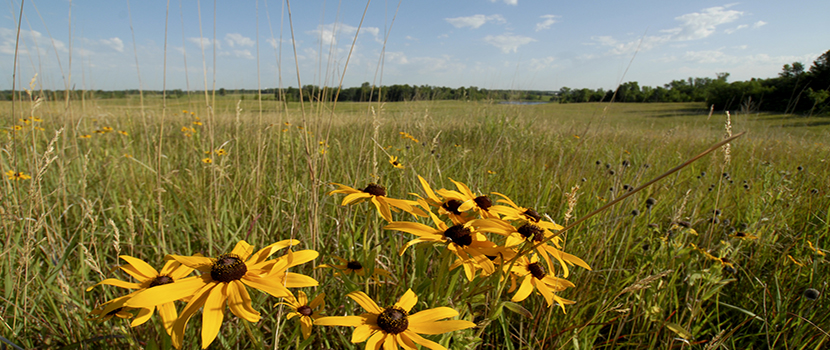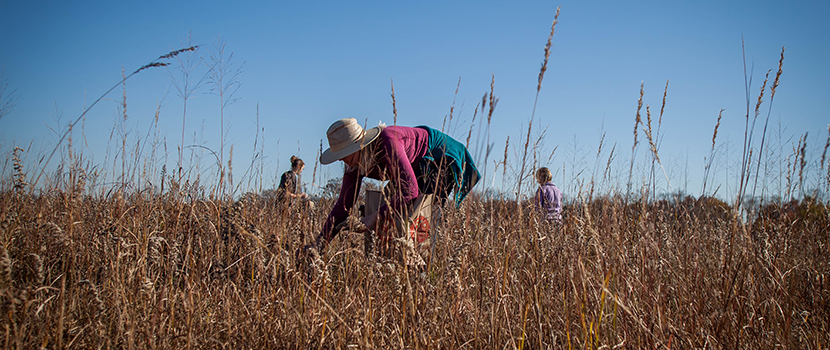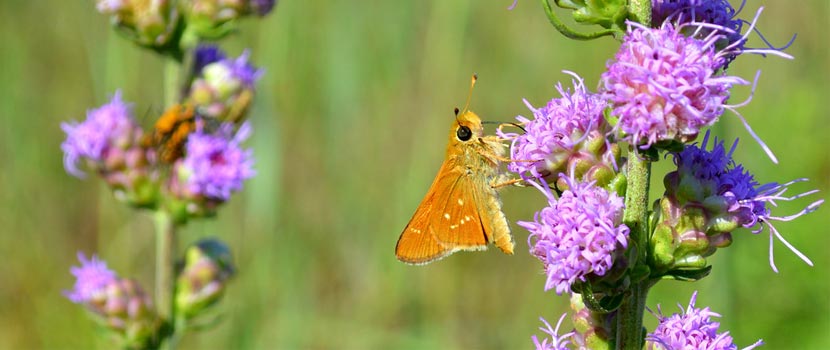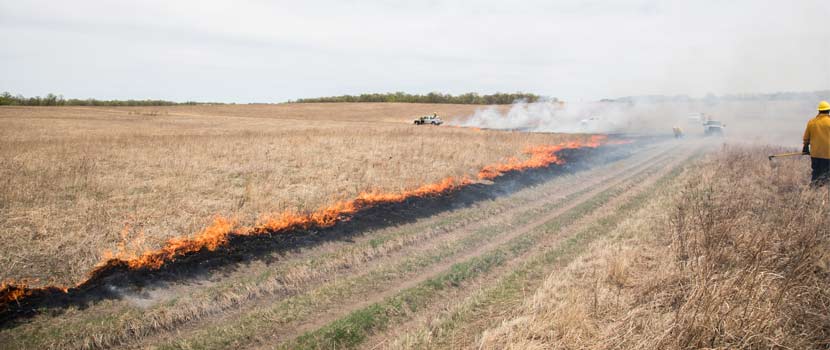Prairies
Today, less than 2% of Minnesota’s prairie habitat remains from the 18 million acres that stretched across the state from southeast to northwest. Three Rivers Park District started re-planting prairies in 1968 and has restored approximately 1,600 acres of prairie habitat. As the largest manager of prairie habitat in the Twin Cities area, that number should expand to 2,000 acres in the coming years.
Three Rivers Park District maintains large prairies at Crow-Hassan, Murphy-Hanrehan and Carver Park Reserves, and other prairies at Hyland Lake Park Reserve, The Landing, Bryant Lake, Kingswood and French Regional Parks.

Celebrating 50 Years of Prairie Restoration
In 2019, Three Rivers Park District celebrates 50 years of prairie restoration, and it all started with Crow-Hassan Park Reserve. What began in the fall of 1969 as less than 20 acres of grasses has turned into an important ecosystem that supports a large diversity of animals, insects, and plants.
Today, with almost 100 wildflowers, Crow-Hassan contains one of the most diverse restored prairies in the state. Uncommon plants such as puccoon, pasque flower and prairie violet grow successfully in Crow-Hassan, while attempts at other locations have not been successful.
These lands aren’t just a refuge for plants. Bullsnakes, plains hog-nosed snakes, and more recently regal fritillary butterflies have been successfully reintroduced in the park. All the birds you would expect in a prairie can be found, including sandhill cranes and the endangered Henslow’s sparrow. Other threatened and endangered species found in the park include the rusty patched bumblebee and Blanding’s turtle.
Explore this wonderful resource on your own, at a special program this summer or by volunteering for a prairie seed collection to support restoration efforts in other parks. Watch for a special celebration this fall on September 21.
Restoration
A variety of land management techniques are used during prairie restoration. Techniques include tree removal, invasive weed control and prescribed burns to restore and reconstruct the tallgrass prairies. These activities are highly visible during the initial planting and establishment phase. Once the prairie starts to mature, the only noticeable management activity is prescribed burns.

There are a variety of plants found in prairie habitat. Prairie grasses and flowers are in bloom from April – October. Some of the common species found in many of Three Rivers’ restored prairies include:
- Big Bluestem (Andropogon gerardii)
- Little Bluestem (Schizachyrium scoparium)
- Switch Grass (Panicum virgatum)
- Junegrass (Koeleria macrantha)
- Side-oats Grama (Bouteloua curtipendula)
- Canada Wild Rye (Elymus canadensis)
- Blue Giant Hyssop (Agastache foeniculum)
- Gray Goldenrod (Solidago nemoralis)
- Gray-headed Coneflower (Ratibida pinnata)
- Lead Plant (Amorpha canescens)
- New England Aster (Symphyotrichum novae-angliae)
- Tall Cinquefoil (Potentilla arguta)
- Purple Prairie Clover (Dalea purpurea)
- Rough Blazing Star (Liatris aspera)
- Round-headed Bush Clover (Lespedeza capitata)
- White Prairie Clover (Dalea candida)
- Wild Bergamot (Monarda fistulosa)
- Wild Lupine (Lupinus perennis)
Restored Prairies
Crow-Hassan Park Reserve
Crow-Hassan Park Reserve in Hanover has over 840 acres of restored prairie. The majority of the prairie was planted in the 1970s, but a recent Lessard-Sams Outdoor Heritage Council Legacy grant allowed an additional 250 acres to be planted in 2015.
Murphy-Hanrehan Park Reserve
In Savage, Murphy-Hanrehan Park Reserve’s prairie was started in the mid-1980s and now spans over 400 acres, including 70 acres that were planted in 2014 using a MN Department of Natural Resources Conservation Partners Legacy grant. Long-term plans exist to tie the three main prairie units together with additional plantings.
Carver Park Reserve
The third largest prairie area is at Carver Park Reserve in Victoria. There has been a small prairie associated with Lowry Nature Center for over 20 years. In the fall of 2016, 165 acres were planted in part with funds from a MN Department of Natural Resources Conservation Partners Legacy grant. This site will be intensely managed for two years to help establish the native plants.
Elm Creek Prairie Restoration Project
Three Rivers Park District is expanding the prairie at Elm Creek Park Reserve from 40 acres to over 200 acres. The existing Elm Creek prairie adjacent to Eastman Nature Center was originally planted in the 1990s. The new restoration sites are currently old fields with non-native and invasive grasses and trees.
Restoration Process
The restoration will start in early to mid-June 2019 with controlled burns at the designated sites. The sites will then be treated with a herbicide to kill the non-native grasses. Later in the summer, they will be seeded with a variety of native grasses and wildflowers similar to what is found in other Park District prairies.
A cover crop of oats will be planted to act as a nurse crop for the prairie plants. Nurse crops prevent erosion, keep too many weeds from growing and help protect perennial seedlings from too much direct sunlight. The initial prep work and seeding will give the new prairies the look of an agricultural field, but this will change over the next three to four years as the newly planted wildflowers start to bloom.
Once the plants start to grow, the new prairie will be intensively managed for two years with occasional mowing and weed control. After that time, the prairie will be managed with occasional prescribed fires.
One of the sites, located south of Lemans Lake, has a large number of non-native and invasive trees and shrubs. These trees and shrubs will be removed by a contractor this coming winter. Any oaks in that area will be kept to help provide savanna-like habitat.
Site Locations
The sites being restored as part of this project are located in multiple areas throughout the park reserve. The most visible sections are just west of the Champlin Community Center and across the street from the dog off-leash area.
Funding
The Park District received a $340,000 grant from the Minnesota Department of Natural Resources Conservation Partners Legacy (CPL) Grant Program, funded through the Legacy Amendment's Outdoor Heritage Fund for this project.
Prairie Seed Collection
Each year, hundreds of volunteers help increase the amount and diversity of seed planted in the more than 1,600 acres of restored prairie managed by Three Rivers Park District.

Volunteer
There are plenty of ways to volunteer in cooperation with the Three Rivers Department of Natural Resources. Put your time to good use by helping to protect and enrich our earth!
Related Blog Posts
Bringing Back Butterflies: What It Takes To Complete A Reintroduction
By: John Moriarty
From securing permits to making sure habitat is just right, a lot of work goes into bringing new butterflies into our parks. Learn all about the process of reintroducing butterflies, our past successes and which butterflies we hope to introduce into our parks in the future.
Planning for a Prescribed Burn
By: John Moriarty
It takes months of planning and preparation to conduct a controlled prairie or woodland burn. As our Natural Resources staff plans for next year's burns, read on to learn about all of the steps they take before ever lighting a fire.
Crow-Hassan Prairie: 50 Years in the Making
By: John Moriarty
This year, Three Rivers is celebrating 50 years of prairie restoration at Crow-Hassan Park Reserve. Learn how it all began and how managing and restoring prairies has evolved since 1969.



